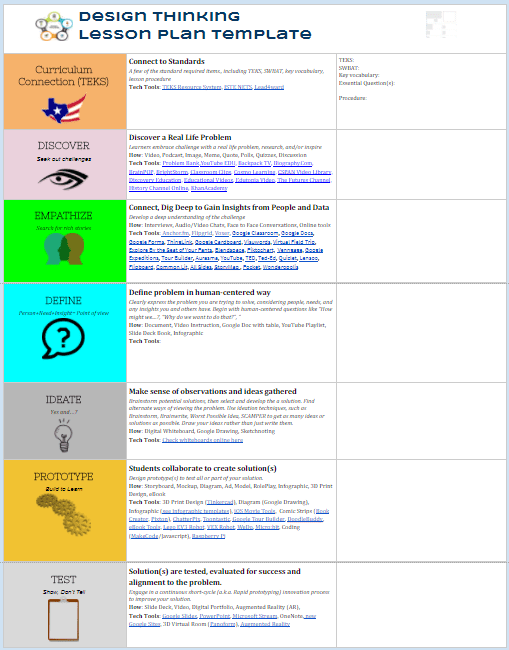“How do you use 3D printing for more than printing toys?” asked Lisa Merrifield (East Central ISD), a workshop participant at a TCEA Makers event held in mid-May, 2018. The question is one I’ve heard time and again, not just for 3D printing. Getting students engaged with new technologies (e.g. 3D printing, Micro:bit, Minecraft: Education Edition, MakeCode) isn’t difficult. What can be tough is setting up environments where students grapple with a real-life problem that requires an engineered solution.
In this blog entry, we’ll explore design thinking, share a design thinking lesson plan format you can adapt for your own needs, and more. Let’s begin.
What is Design Thinking?
A wealth of information exists about design thinking. Some large urban school districts are embracing it at elementary, middle, and high school. One person contacted me this past May sharing that she would be responsible for professional development. Before we explore some of the questions she asked, let’s take a look at how some define it.
Design Thinking is an iterative process in which we seek to understand the user, challenge assumptions, and redefine problems in an attempt to identify alternative strategies and solutions that might not be instantly apparent with our initial level of understanding. At the same time, Design Thinking provides a solution-based approach to solving problems. It is a way of thinking and working as well as a collection of hands-on methods.
Source:Interaction Design.org
To save space and time, and since I’ve embedded the recursive process (with explanations) in my version of a Design Thinking lesson plan, I’ll skip the longer explanation. You can read the short version of my explanation online.
How Do I Begin Planning a Design Thinking Lesson?
This request arrived in my inbox after I finished facilitating the TCEA Lunch-and-Learn webinar (FREE for TCEA members):
“I’m presenting Design Thinking for K-2 and my coworker is presenting for 3-5. Our plan is for teachers to experience a design thinking lesson, explain design thinking, and then have them plan a lesson specific to their grade level for the start of the school year. That is where I’d like some guidance/template so they don’t feel totally overwhelmed.”
To respond to this request, I took the liberty of adapting a variety of online resources to create my own design thinking lesson plan form.

Design Thinking Lesson Plan Template (View full-size version | Get a copy in Google Docs format)
This lesson plan template is designed to be completed online in digital format, either as a Word Online or Google Docs document. Source citations are included in the full-size version linked above. (A quick aside: Future design thinking blog entries will feature actual examples for 3D printing and coding).
How Do We Create a “Design Thinking” Classroom?
When we begin from a design thinking point of view, we start with an environmental scan. What works or doesn’t work around us? Who can we speak to to achieve deeper insight into how a problem slows or stops forward movement towards a goal? For classroom teachers, the challenge can involve setting situations that empower students to adopt a solution-based approach to problems. One key difference from problem-based learning (PBL) is that teachers define the problem, making curricular connections. It is tempting to do the same with design thinking. The easiest way to avoid this involves focusing on curriculum-aligned STEM Do It Yourself activities, including makerspace activities. These activities often introduce students to “making,” engineering without a well-defined problem. Four points to keep in mind:
- Empower student ownership. Students need ownership of the problems they begin to solve, not just engagement due to an interesting, teacher-created problem
- Create your own problem bank. Using a tool like Microsoft or Google Forms, invite others to share their problems. For example, for 3D printing, see this Design Thinking Problem Bank. You may also want to read How to Create Your Own Problem Bank and What Makes a Good Problem Bank.
- Put students in charge of selecting problems. Use a rubric like this one (click the link to get a copy) to get started. Remember, selecting a problem is a pre-Design Thinking process step. As a teacher you can do it, but it is better to empower students to empathize, ideate, and define the problem.
- Focus students on engineering as a key component (Source: Kindling STEM Learning). Given access to 3D printers and coding solutions, engineering a solution first with spaghetti noodles and marshmallows or duct tape wallets, can be powerful, inexpensive alternatives. Find more projects online.
Parting Thoughts
As you begin to institutionalize approaches like design thinking in your organization, support teachers’ efforts. To accomplish that, provide baseline design thinking professional learning. Also, put together design thinking projects and easy-to-gather resource collections to support these efforts. While some campuses executed FOSS kits with fidelity, others have flopped due to lack of access to supplies. Implementing a resource-intensive program isn’t new; just requires a systemic, systematic approach. Another component must involve instructional coaching that supports teachers in the field.

